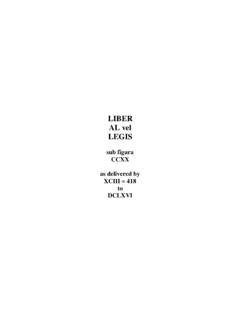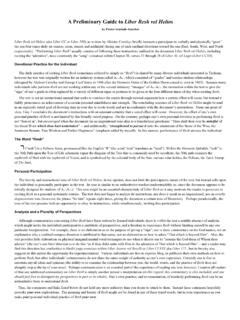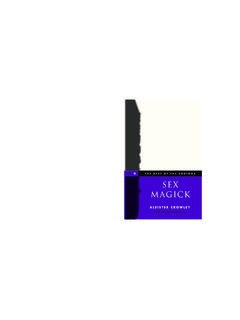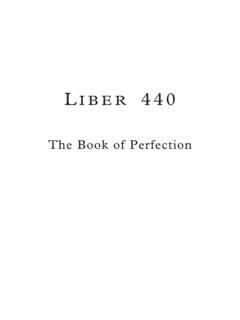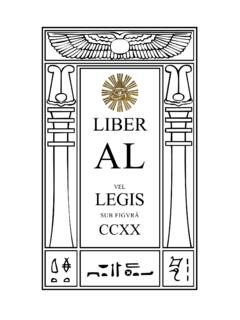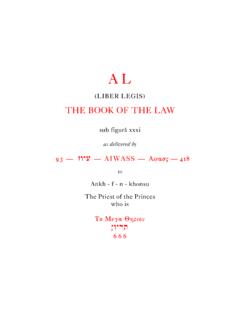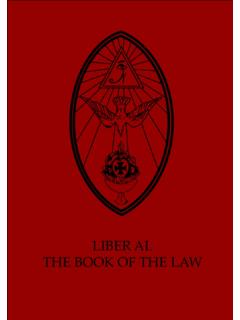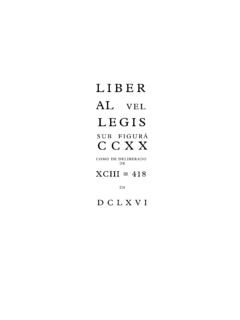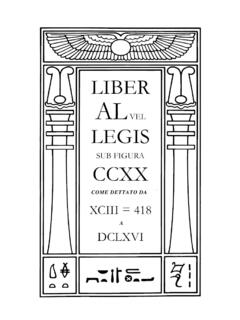Transcription of Liber XXVII vel EQ - astronargon.us
1 Liber XXVII vel EQ Publication in Class C by Frater Abraxas Introduction This present work is both a response and a continuation of the work on the English Qabalah initiated by Frater Zephyros in Liber 805 vel EQ. The purpose of this work is not to demonstrate the validity of the English Qabalah derived in Liber 805; anyone seeking the proofs of this system should consult that work itself; and it is recommended to read that work before reading this one since the developments in this work are built upon the foundations of the former. Therefore I have included a copy of this work in the appendix section to facilitate this.
2 In Liber 805 Frater Zephyros discusses the difficulties faced by Crowley and latter Thelemnites at developing an EQ as mandated in Liber Al: AL : "Thou shalt obtain the order & value of the English Alphabet; thou shalt find new symbols to attribute them unto." Crowley had set about this and claimed to have achieved this task through his reception of Liber Trigrammaton, which he felt provided the skeleton for the new symbols to be attributed to the English letters. The problem is that he realized his theoretical attribution of the letters to the Trigrams was not workable; giving neither an order nor a value of the letters.
3 Here is the following comment that he wrote in response to the aforementioned verse of Liber Al: 55. Next, he set me a fresh task. I was to assign values to English letters of some such order as obtains in Hebrew. I deal fully with this matter elsewhere1. THE OLD COMMENT Done. See Liber Trigrammaton, Comment. THE NEW COMMENT The attribution in Liber Trigrammation is good theoretically; but no Qabalah of merit has arisen therefrom. (Surely it is a little early for that; a good Qabalah may take a few hundred years to unfold.) [The italics are from Motta here.] I am inclined to look further into the question of Sanskrit Roots, and into the Enochian Records, in order to put this matter in more polished shape.
4 (Cf: Liber Al Commented) Many Thelemnites including Frater Zephyros have questioned whether or not Trigrammaton really did provide an adequate framework by which to attribute new symbols to the English alphabet. It is the goal of this work to show that Crowley did in fact fulfill the prophecy in Liber Al, by receiving Trigrammaton and that the symbols in Trigrammaton provide new Heiroglyphs for an English Qabalah along with clues as to how the order and value should be obtained. Here, I will endeavor to show that the number of Trigrams in Trigrammaton actually validates the method by which the order and value of the English Alphabet is obtained in Liber 805.
5 This work will also endeavor to demonstrate how the connotations of the letters in English American culture compliment the ideas suggested by the trigrams and their holy verses when they follow this ordering. In Liber 805 the order of the English Alphabet was obtained in the same manner as the order of the letters in the Hebrew Qabalah. This is a credible maneuver from the start since the Hebrew Qabalah is easily considered one of the most complete and elementary works on Qabalah, and it has set the normative standards of operation for the other Qabalahs such as the Greek and Enochian variations. Another important point in favor of mirroring the Hebrew method of obtaining the order of the letters is that, They [the Jews] have the half: unite by thine art so that all disappear.
6 Al. This suggests that the methods used to acquire the order and value in the Jewish Qabalah may be used to set the standard by which Thelemic culture is to develop its own system. It also suggests that any Thelemic Qabalah should appear as a mirror image of the Hebrew one in other respects such as it s gematria. The fact that much of the gematria produced by the EQ of Liber 805 provides a thrashrq of the values of its holy words in the Hebrew testifies to this. The most compelling example of this occurs with the word ABRAHADABRA which is valued at 418 in the Hebrew Qabalah and 814 in the EQ. This along with many other variations discussed in Liber 805 provides compelling evidence that this EQ fits the bill for being the other half of the Jews spoken of in Liber Al.
7 Liber 805 imitates the Hebraic tradition by looking for the order and value of the English alphabet in the Book of the Law itself. This is fitting since it is in the context of Thelema and its central revelation that such value would have any meaning. Zephyros explains that: The Hebrews started at the beginning (Berashith). By comparison; we have the first verses to the Book of the Law. The sequential order of the English letters as they make their first appearance in the tome is now a parallel idea. (Cf: Zephyros Liber 805) The order obtained by this method appears thus: H A D T E M N I F S O U V L G C P Y R W B K J Z X Q This arrangement is arrived at from counting the natural order of the letters, and Frater Zephyros points out the significance of the fact that it is only in the first chapter (the beginning) in which all twenty six letter of this alphabet are utilized.
8 This order is then utilized to assign an appropriate number to each letter based on its placement in the series and following the Hebrew and Greek pattern of going from 1 to 10 to 20, 30, and from 90 to 100, and up. Thus we have: H=1 A=2 D=3 T=4 E=5 M=6 N=7 I=8 F=9 S=10 O=20 U=30 V=40 L=50 G=60 C=70 P=80 R=100 W=200 B=300 K=400 J=500 Z=600 X=700 Q=800 Again for further details about how this version of the EQ is derived and to refrain from reinventing the wheel with this treatise, I strongly encourage the reader to consult Liber 805. Using this order and value of the letters presented above, I add each letter to the trigrams as part of my commentary on the book itself.
9 I follow this order of the letters beginning with the second trigram since the first trigram portrays silence and hence the period from the written English. This is the first key to matching the letters with the trigrams, and the commentary in the remainder of this work is based on the connection between the ideas portrayed by the trigrams, the verses of the book itself, and the association of ideas attributed to the alphabet through our English culture. Since the goal of this work is to show how the trigrams and verses of Trigrammaton can provide a Thelemic book of Hermes much in the same way as the Tarot in relation to the Hebrew alphabet, I have also explored some possible connections existing between the Tarot trumps in addition to the English alphabet.
10 The foundation for the suggested correspondences are based on the meaning suggested by the verses of Trigrammaton itself rather than a rigid adherence to the correspondences worked out in Liber 777 between the traditional trigrams of the I-ching and Western Hermeticism. It is important to remember that the trigrams of Trigrammaton comprise a unique system of symbols that is self defined by the holy verses which may share in some of the ideas from the I-ching, yet it is a distinct and comprehensive pentacle in its own right. Final appeal for symbolic meaning should be within the context of the book itself with any overlapping Chinese ideas being secondary sources of authority in our Hermeneutical exegesis.
